DEFINITION
(a) History of Microbiology: The study of microorganisms is called Microbiology (micro = small, bios = life, logos = study). the microorganisms include
bacteria, fungi, viruses, algae and protozoans.
(b) Habitat of Microorganisms:
MICROORGANISM
Microorganisms are present in the air, water, food and even inside our bodies. While a majority of the microbes are harmless, some of them have the
capability of causing dangerous diseases.

Classification of Microorganism
Microbes are mainly classified into five major groups :
I. Bacteria : Bacteria (singular: bacterium) are single-called organisms that vary in shape and size. Some bacteria are round or oval (coccus), others are
rod-shaped (bacillus) or spiral. Some bacteria are autotrophic as they contain chlorophyll, but most of them are heterotrophic, showing saprophytic or parasitic
mode of nutrition. Bacteria are very small organisms which are visible under the light microscope.
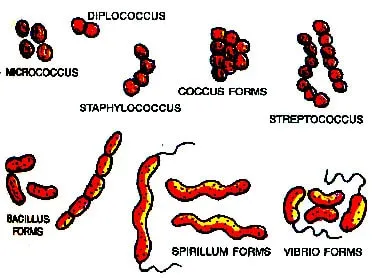
II. Algae : Autotrophic organisms having undifferentiated plant bodies are called algae (singular: alga). Algae occur abundantly, like grass in
aquatic habitats and are also called 'grass of water'.
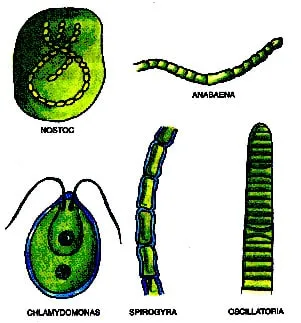
Some forms of algae
III. Fungi : Fungi (singular: fungus) are a group of plant-like organisms exhibiting heterophic (saprophytic or parasitic) nutrition. They are commonly found
on bread, leather, cotton, paper, etc. Fungi grow vigorously in damp, warm, dark places, Yeast, moulds and mushrooms are forms of fungi. Yeast, moulds
and mushrooms are forms of fungi. Yeast is commonly used for baking breaed, cakes, etc. The yeast ferments sugar present in the wheat and converts it to
carbon dioxide and alcohol. The gas expands, so that the dough (kneaded atta) rises, giving shape and flavour to the preparation.
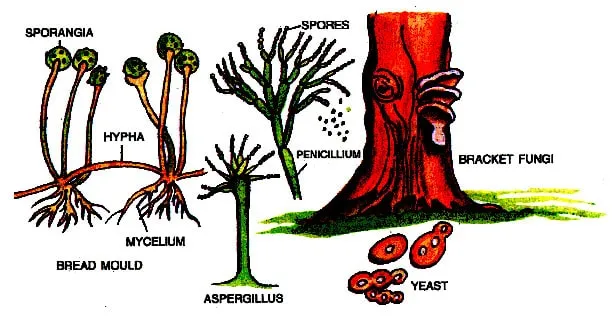
Some forms of fungi
IV. Protozoa : Unicellular organisms that exhibit animal-like characteristics are called protozoa (singular: protozoan). The word protozoan literally
means 'the first animal'. Most protozoa are heterotrophic.
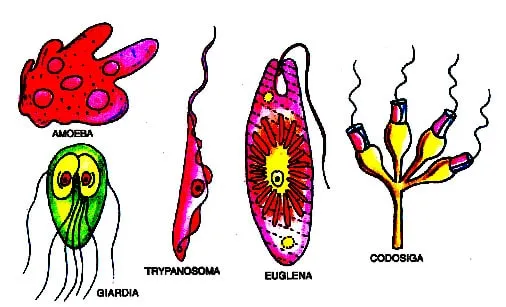
Fig. Some forms of Protozoa
V. Viruses : A virus is a microorganism which exhibits characteristics of living as well as non-living things. Viruses exhibit a variety of shapes, having
simple structure. Reproducing only inside a living organism, viruses can cause many diseases.
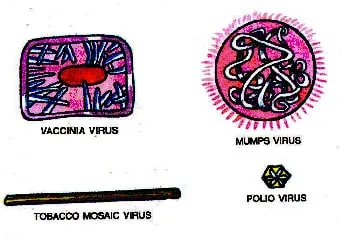
Fig. Some forms of viruses
Useful Microorganisms
Humans have many microorganism in their in their digestive system that contribute to overall health. The microbial community in humans not only protects
us from disease, but also provides necessary vitamins. Bacteria also help in nitrogen fixation in production of antibiotics, etc. Algae are also useful in a number
of industries. Therefore, even through microbes are responsible for food spoilage and many diseases, they can also be very helpful.
Some microorganisms and their uses are listed in Table :
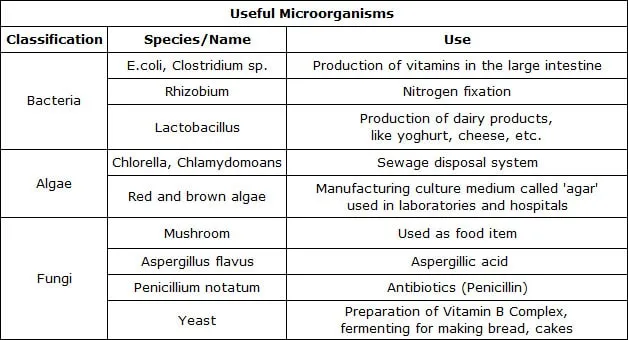
Yoghurt or curd (dahi) is the commonest example of beneficial use of microbes. Youghurt is a part of our daily diet and we eat it in various forms,
with different flavour. This dahi is made from milk by the action of a bacterium called lactobacillus or latic acid bacteria. It converts the sugar in milk
(lactose) to lactic acid, giving curd its sour taste. This process was initially used as a way to preserved milk.
![]()
Curdling of milk takes places naturally, due to heat (specially in summer).
Curding of milk also takes place due to addition of any of the acid products such as sour curd, lemon juice and even tomato juice.
Harmful Microorganisms
The disease causing microorganisms are called pathogens. It is necessary to protect ourselves from the different diseases caused by microorganism or germs.
The commonest mode of entry for these germs is the food we eat and the water we drink. Some harmful microorganisms and the diseases caused are given in Table :
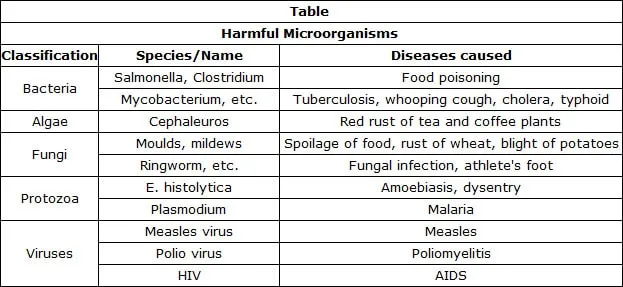
Sometimes, disease carrying germs are carried by other organisms. For e.g. The pathogen for malaria is carried by a mosquito (the female Anopheles, mosquito)
and enters the body when the mosquito bites. Here, the mosquito acts as a carried while the human is the host. Since mosquitoee are capable of carrying and spreading
many diseases like malaria, dengue, etc. It is very important to control the reproduction or breeding of mosquitoes. Since mosquitoes breed on water, we must ensure
that there is no standing rain water or water in coolers, etc. near our homes.
VI. How is food spoilt ? Some foods get perished easily, if not stored in refrigerators. For example, foods like fruits, vegetables, cooked food get spoilt if kept
at room temperature. Fungal growth on breaed (called bread mould) is seen commonly, espcectally in rainy season. Spoilage of food is due to the action of
microorganisms present in the food or outside. In summers milk goes rancid (curdled) due to high temperature, that's why it needs to be stored in a cool and
dry place. Find out the reason why pulses, grains and spices do not get spoilt, like fruits & vegetables.
Methods of Food Preservation
What do you do with left-over food after dinner ? It is kept in the fridge. If left outside, the food can get spoiled, and can cause food poisoning if eaten.
We have seen how dangerous microorganisms can be. That is why it is very important for us to be careful about food quality and preservation. Different methods
used to prevent spoilage of food, by limiting the growth of microbes are :
VII. Refrigeration : Food is kept at low temperature to reduce the rate of reproduction of the microorganisms and prevent food spoilage.
VIII. Dehydration or drying : Food items are dried in the sun or by spraying or freezing. This process is commonly used for preserving fruits, although some
nutrients are lost by drying.
IX. Addition of salt or sugar : Microbes need water for growth. By adding salt or sugar, water is made unavailable, thereby controlling microbial growth. Pickels
and jams are preserved food items (fruits and vegetables) and can be kept for many months.
X. Freezing : Frozen food is very popular nowadays as it has greater shelf life, without much loss of nutrients. Reduction in temperature and unavailability of
water help to limit microbes.
XI. Smoking : Meat products are preserved by the process of smoking which uses drying technique as well as some substances from smoke.
XII. Pasteurization and Homogenization : Pasteurization is a process by which microorganisms are destroyed by high temperature and sudden cooling. Milk is
heated to around 70ºC and then suddenly cooled. It is commonly used for milk, since other food items can lose heat-sensitive nutrients.
Homogenization is the process of passing a substance (usually milk) under high pressure through thin tubes, which reduces the tendency of creaming of fat.
XIII. Canning : Canned products are first subjected to high heat processing, then sealed in cans. While canning increases shelf life. care must be taken to ensure
that the cans are not damaged or bulging, which would indicated spoilage..
XV. Sterilization : Ionizing radiations are used to destroy microorganisms without affecting heat-sensitive nutrients. This process is commonly used for preservation
of mushrooms, strawberries, potatoes, etc.
The microbial world is fascinatingly vast, with different species and types of organisms, ranging from the helpful intestinal bacteria to the deadly viruses. The presence
of microorganism in food must by examined and care must be taken to ensure proper cookig and preservation of food.
Nitrogen Fixation
The process of converting atmospheric nitrogen into compounds of nitrogen, mainly nitrates, which can be easily used by plants is called nitrogen fixation. If
can be fixed in two ways.
1. Natural fixation or Atmospheric fixation
2. Artificial fixation or Industrial fixation.
XVI. Natural Fixation of Nitrogen
In nature nitrogen of the atmosphere can be fixed by three methods which are listed below.
(i) Fixation of Nitrogen by Bacteria : The root nodules of certain legnminous plants like peas, beans, etc. contain nitrogen fixing bacteria called Rhizobium. The
bacteria can directly fix nitrogen gas to nitrogen compounds which can then the utilised by the plants. Some non-leguminous plants like Alnus and Ginkgo also fix atmospheric nitrogen.
(ii) Fixation of Nitrogen by Blue - Green Alge : Blue-green algae like Nostoc and Anabaena can also help in nitrogen fixation. These are usually found in paddy fields.
The fixation of nitrogen by bacteria and algae is called biological fixation of nitrogen. Most of the nitrogen in nature is fixed by this method
(iii) Fixation of Nitrogen by Lightning :During lighting in the sky, when high temperature is produced, the nitrogen gas of the atmosphere reacts with oxygen to
form nitrogen oxide. This nitrogen oxide dissolves in rainwater to form a very dilute solution of nitric acid. The nitric acid thus formed reacts with alkalis present in the soil
to form nitrates which are then absorbed by the plants.
XVII. Artificial fixation of Nitrogen : In this method the atmospheric nitrogen is made to combine with hydrogen gas to form ammonia (Haber's process). This ammonia
can be oxidized to make nitrates or react with acid to form ammonium salts. The nitrates as well as ammonium salts contain fixed nitrogen and are used as fertilisers.
Nitrogen Cycle
The circulation of nitrogen through the living and non-living components of the biosphere (air, soil, water, plants and animals) is called nitrogen cycle. Nitrogen cycle
maintain the percentage of nitrogen in the atomosphere more or less at a constant.
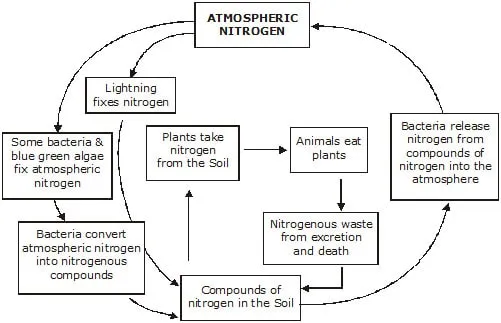
XVIII. Steps Involved in Nitrogen Cycle
(i) The atomspheric nitrogen is fixed into nitrogen compounds like nitrates hy Rhizobium bacteria, blue-green algae, lightning or industrial method.
(ii) The plants absorb nitrate compounds from the soil and water and convert them into plant proteins.
(iii) The plants are eaten up by animals and thus plant protiens are used for making animal proteins.
(iv) When the plants and animals die, the putrefying bacteria and fungi present in the soil decompose the protiens of dead plants and animal into ammonia.
This process is called ammonification.
(v) Ammonia thus formed is converted first into nitrites and then into nitrates by the action of Nitrosomonas and Nitrobacter bacteria respectively. The process
is called nitrification. These nitrates are again absorbed by plants and the cycle is repreated.
(vi) The soil contians denirifying bacteria called Pseudomonas which convert nitrate form of nitrogen into free nitrogen which goes back into the atmosphere.
The process is called denitrification.
NCERT QUESTIONS WITH SOLUTIONS
Q.1 Can microorganisms be seen with the naked eye? If not, how can they be seen?
Ans. No, microorganisms can not be seen with naked eyes. They are so small that they can not be seen with naked eyes. A microscope is required to see these organisms.
Q.2 What are the major groups of microorganisms?
Ans. Microorganisms are mainly divided into five groups: Bacteria, Fungi, Protozoa, Algae and virus.
Q.3 Name the microorganisms which can fix atmospheric nitrogen in the soil.
Ans. Certain type of bacteria and blue green algae fix atmospheric nitrogen. For example Bacteria like Rhizobium, Azotobacter and blue green elgae like Anabaena, Nostoc.
Q.4 Write ten lines on the usefulness of microorganisms in our lives.
Ans. Microorganisms are very useful to us. Some of their usefulness is as follows:
(i) They are used in the preparation of curd, bread and cake. Lactobacillus promotes the formation of curd and Yeast in the baking industry.
(ii) Commercially microorganisms are used for the large scale production of alcohol, wine and vinegar.
(iii) Yeast is used for commercial production of alcohol and wine while. Acetobacter bacteria cause conversion of alcohol to vinegar.
(iv) In medical industry antibiotics are made from microorganisms like some fungi and bacteria.
(v) Microorganisms are also used to prepare vaccines for various diseases.
(vi) Microorganisms (bacteria) help us in cleaning of our environment as they decompose the dead bodies of plants and animals and other organic wastes.
(vii) In agriculture, microorgansims are used to increase soil fertility by fixing nitrogen.
(viii) Some bacteria like - Rhizobium and some blue green algae are able to fix nitrgoen from the atmosphere to enrich soil and thus increase its fertility.
(ix) It is due to the activities of microorganisms because of which we are able to prepare manure by decomposing organic wastes and dead bodies of plants and animals.
(x) In food industry, they are used as preservatives for food items. Further, some fungi are eaten raw as food such as, Mushrooms.
Q.5 Write a short paragraph on the harms caused by microorganisms.
Ans. Microorganisms can be very harmful to us, as they cause a number of human and animal diseases. Diseases in humans like common cold, tuberculosis, measles,
chicken pox, polio, cholera, typhoid, hepatitis-B, malaria etc. all are caused by microorganisms. Some serious diseases like- Anthrax is a dangerous human and cattle
disease caused by a bacterium. Microbes grow on food products and render them unfit for consumption. Consumption of such food causes food poisoning. Microbes also
spoil clothes and leather products. Microorgansims cause diseases of plants like-blights in potatoes, sugarcanes, oranges, rust of wheat citrus canker etc. Tehy also reduce the crop yield.
Q.6 What are antibiotics? What precautions must be taken while taking antibiotics?
Ans. Medcines taken to kill or stop the growth of hamrful or disease causing microbes in human body are called antibiotics. Antibiotics are very useful as only antibiotics
can save us from many microbial infections and diseases. Antibiotics are made from fungi and bacteria. Alexander Flemming discovered the first antibiotic called Penicilling
in 1929. Now a day a number of antibiotics are used to cure a variety of human, animal and plant diseases. Streptomycin, Erythromycin, Tetracycline etc are some commonly used antibiotics.
Precautions for taking antibitotics: Antibtiotics should only be taken when advised by a qualified physiciian. Moreover it should only be taken when needed otherwise,
they became less effective for future use. Also antibiotics taken unnecessarily may kill the beneficial bacteria in the body.
EXERCISE - I
Q.1 Microorganisms help plants in nitrogen fixation.
Q.2 Reprodcution of microbes reduces with increase in temperature.
Q.3 Organism used in the production of cheese.
Q.4 Disease caused by eating spoiled food.
Q.5 Microorganisms exhibiting both and non-living characteristics.
Q.6 Mode of nutrition of algae.
Q.7 Give examples from daily life about the beneficial effects of microorganism.
Q.8 Explain the differences between algae and fungi.
Q.9 What is food poisoning and how can it be prevented ?
Q.10 What is the use of antibiotics for fighting an infection ?
Q.11 Viruses are considered on the borderline of living and non living.
Q.12 Salt is added to pickles in larger amount.
Q.13 Algae is called grass of water.
Q.14 Name the causes of typhoid ?
Q.15 Name a bacteria fixing atmospheric nitrogen in roots of legyminous plants.
Q.16 Name the cause of malaria
Q.17 What is Nitrification
Q.18 What is meant by denitrification ?
Q.19 What are microorganisms or microbes ?
Q.20 Give two examples of microorganisms
Q.21 Wat are the four major groups of microorganisms ?
Q.22 What are viruses ?
Q.23 What is fermentation ?
Q.24 What are antibiotics ?
Q.25 What is vaccine ?
Q.26 Name a most popular vaccination programme.
Q.27 Name two communicable diseases.
Q.28 What are preservatives ?
Q.29 Mention the amount of nitrogen gas in atmosphere.
Q.30 How do microorganisms survive under adverese conditions. ?
Q.31 Explain the commercial use of microorganisms.
Q.32 Explain nitrogen cycle and draw a schematic diagram of nitrogen cycle.
Q.33 Explain the uses of Bacteria, Fungi and Algae.
EXERCISE - II
Q.1 Botulism is caused by :-
(A) Salmonella typhae
(B) Clostridium botulinum
(C) Crasticium botulinum
(D) Staphylococci
Q.2 Bacterial infection of food can be prevented by :-
(A) covering the food
(B) keeping the food very cold
(C) heating the food upto 70°C at least (D) Both (A) and (C)
Q.3 Elephantiasis is caused by :-
(A) Anopheles mosquito
(B) Culex mosquito
(C) tsetse fly
(D) Plasmodium
Q.4 Bacteria bearing flagella all over body are-
(A) Peritrichous (B) Atrichous
(C) Monotrichous (D) Cephalotrichous
Q.5 BCG stands for :
(A) Bacillus carol gram
(B) Bacillus Chalmette Guerin
(C) Bacteria Chalmette Guerin
(D) None of the above
Q.6 DPT Vaccine is for :
(A) Diptheria, Polio, Tetanus
(B) Diptheria, Pertussis, Tetanus
(C) Diptheria, Pertussis, Typhoid
(D) Diptheria, Pertussis, Tuberculosis
Q.7 MMR vaccine is given for :
(A) Malaria, Mumps, Rubeolla
(B) Mumps, Measles, Rabies
(C) Mumps, Measles, Rubeolla
(D) None of the above
Q.8 Ring worm spreads through :
(A) Contaminated food and water
(B) Direct skin contact
(C) Insects
(D) Contaminated air
Q.9 World TB day is celebrated on :
(A) March 21 (B) March 24
(C) March 30 (D) March 18
Q.10 Who discovered antibiotic streptomycin effective against Tuberculosis :-
(A) Selman A. Waksman
(B) Louis Pasteur
(C) Robert Koch
(D) Iwanowsky
Q.11 In Blue green algae, the structure specialised for nitrogen fixation is
(A) Thylakoid (B) Harmogonia
(C) Heterocyst (D) Endospore
Q.12 The similarity between bacterium and cyanobacterium is in the presence of
(A) Flagella (B) Nucleoid
(C) Size (D) 80S ribosomes
Q.13 Mycoplasma differ from bacteria in
(A) Not having a cell wall
(B) Having organised nucleus
(C) Having organised cell organelles
(D) None of the above
Q.14 Escherichia coli in human intestine synthesises
(A) Vitamin B and D
(B) Vitamin B and C
(C) Vitamin A and K
(D) Vitamin B and K
Q.15 The smallest bacterium is
(A) Spirochaete
(B) Dialister pneumosintes
(C) Vibrio
(D) Lactobacillus
Q.16 Bacteria having a tuft of flagella at one end are called-
(A) Peritrichous (B) Monotrichous
(C) Lophotrichous (D) Amphitrichous
ANSWER KEY
1. B 2. D 3. B 4. A
5. B 6. B 7. C 8. B
9. B 10. A 11. C 12. B
13. A 14. D 15. B 16. C
EXERCISE - III
1. In Blue green algae, the structure specialised for nitrogen fixation is
(A) Thylakoid (B) Harmogonia (C) Heterocyst (D) Endospore
2. The most ancient group of organisms on the earth is
(A) Eubacteria (B) Cyanobacteria (C) Archaebacteria (D) PPLO
3. The similarity between bacterium and cyanobacterium is in the presence of
(A) Flagella (B) Nucleoid (C) Size (D) 80S ribosomes
4. The figure given below shows microorganisms W, X and Y. Identify them.
W X Y
(A) virus protozoan fungus
(B) alga bacterium virus
(C) virus fungus protozoan
(D) fungus alga bacterium
5. Which one of the following statements is correct?
(A) Legumes fix nitrogen through specia!ised bacteria that lives on their leaves.
(B) Legumes are incapable of fixing nitrogen
(C) Legumes fix nitrogen only through specialised bacteria that lives in their roots.
(D) Legumes fix nitrogen independently of the specialised bacteria that live in their roots.
6. Rocky mountain spotted fever is caused by
(A) Rickettsias (B) Fungi (C) Bacteria (D) PPLO
7. The witches broom of legumes is caused by a
(A) Bacterium (B) Fungus (C) Mycoplasma (D) Virus
8. The bacteria which commonly lives in animal and human intestine
(A) Vibro cholerae (B) Bacillus anthracis (C) Corynebacterium (D) Escherichia coli
9. The figure given below shows the method of reproduction of a microorganism.
Which of the following combination is correct ?
Microorganisms Method of reproduction
(A) Viruses Binary fission
(B) Fungi Budding
(C) Algae Conjugation
(D) Fungi Spore formation
10. Mycoplasma differ from bacteria in
(A) Not having a cell wall
(B) Having organised nucleus
(C) Having organised cell organelles
(D) None of the above
11. Escherichia coli in human intestine synthesises
(A) Vitamin B and D (B) Vitamin B and C
(C) Vitamin A and K (D) Vitamin B and K
12. Who gave bacteria the present name?
(A) Leeuwenhoek (B) Edenberg (C) Alexander Fleming (D) E.R. Roux
13. Which of the following bacteria infests canned food?
(A) Salmonella (B) Clostridium botulinum
(C) Staphylococcus aureus (D) Salmonella enteridis
14. Which cyanobacteria provide characteristic colour to red sea
(A) Microcystis (B) Oscillatoria (C) Rivularia (D) Trichodesmium
15. The smallest bacterium is
(A) Spirochaete (B) Dialister pneumosintes
(C) Vibrio (D) Lactobacillus
16. Vascular tissue is present in all except
(A) Fern (B) Mango (C) Pinus (D) Algae
17. A bacterial cell divides once in every minute. It takes one hour to fill a cup. How much time will it take to fill half the cup ?
(A) 32 minutes (B) 60 minutes (3) 59 minutes (4) 29 minutes
18. Pond silk is the common name of
(A) Volvox (B) Chlamydomonas (C) Euglena (D) Spirogyra
19. Kelp is obtained from
(A) Marine algae (C) Aquatic plants (C) Lichens (D) Bryophytes
20. A parasitic algae is
(A) Porphyra (B) Cephaleuros (C) Harveyella (D) Laminaria
21. The largest algae is
(A) Fucus (B) Macrocystis (C) Laminaria (D) Sargassum
22. Pyrenoid is found in one of the following organelles of Spirogyra.
(A) Nucleolus (B) Chloroplast (C) Cytoplasm (D) Vacuole
23. The photosynthetic pigment present in all classes of algae is
(A) Chlorophyll-b (B) Chlorophyll-a (C) Carotenoids (D) Phycobilins
24. Agar is commercially obtained from:
(A) Gelidium (B) Cladophora (C) Chlorella (D) Corallina
25. Which of the following algae have cup shaped chloroplast?
(A) Spirogyra (B) Volvox (C) Chlamydomonas (D) Chlorella
26. A unicellular algae useful for extraction of antibiotic chlorellin is
(A) Laminaria (B) Dictyota (C) Chlorella (D) Trichodesmium
27. The figures given below shows four types of microorganisms P, Q, R and S. What microorganisms are represented by P, Q, R and S respectively ?
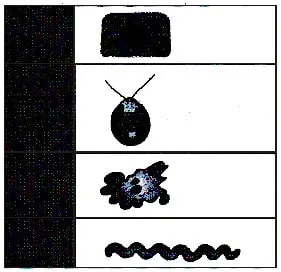
P Q R S
(A) Bacteria Protozoa Viruses Algae
(B) Protozoa Viruses Algae Bacteria
(C) Viruses Algae Protozoa Bacteria
(D) Algae Protozoa Bacteria Viruses
28. Algae and other water plants often float on water during day time and sink at night because: .
(A) They are attracted by sunlight.
(B) They become buoyant due to accumulation of O2 during day time.
(C) They lose weight at night.
(D) None of the above.
29. What would happen if Spirogyra is placed in salt-water?
(A) It will swell due to osmosis. (B) Protoplasm shrinks due to plasmolysis.
(C) There is no change in the filament. (D) None of the above.
30. What acts as an anchoring structure in algae?
(A) Hold-fast (B) Lamina (C) Stipe (D) None of these
31. What are coralline algae?
(A) Green algae are known as coralline algae.
(B) Algae present in fresh water are known as Coralline algae.
(C) Some red algae accumulate calcium carbonate from sea water and deposit it over their walls. They are known as coralline algae.
(D) Coralline algae do not exist.
32. Which algae are considered as ancestors of land plants?
(A) Brown algae (B) Red algae (C) Green Algae (D) Blue-green algae
33. Saccharomyces cerevisiae is
(A) Baker's yeast (B) Beer yeast (C) Both a and b (D) Wine yeast
34. Fungi resemble human beings in :
(A) The nature of food reserve. (B) Having heterotrophic mode of nutrition.
(C) The mode of respiration. (D) All of these
35. Yeast contains maximum amount of
(A) Vitamin C (B) Riboflavin (C) Protein (D) Carbohydrate
36. Which of the following are represented by P, Q, R and S in figure given below ?
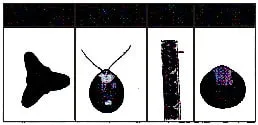
(A) P - Diatom, Q - Chlamydomonas, R - Spirogyra, S - Volvox
(B) P - Volvox, Q - Chlamydomonas, R - Spirogyra, S - Diatom
(C) P - Volvox, Q - Diatom, R - Spirogyra, S - Chlamydomonas
(D) P - Spirogyra, Q - Volvox, R - Diatom, S - Chlamydomonas
37. Yeast differs from bacteria in being
(A) Multicellular (B) Prokaryotic (C) Eukaryotic (D) Unicellular
38. Common form of stored food in fungi is :
(A) Glucose {b) Sucrose (C) Starch (D) Glycogen
39. Fungi are characterized by
(A) Absence of chlorophyll (B) Present of chitin in cell wall
(C) Presence of mycelium (D) All of them
40. Fungus used in genetic experiments .
(A) Neurospora (B) Rhizopus (C) Mucor (D) Claviceps
41. The lichens represent symbiotic relationship between
(A) Algae and fungi
(B) Viruses and fungi
(C) Algae and bacteria
(D) Viruses and bacteria.
42. Which one of the following is not true for lichens?
(A) Some form food for reindeer in arctic region.
(B) Some species can be used as pollution indicators.
(C) These grow very fast at the rate of about 2 cm. per year.
(D) Their body is composed of both algae and fungal cells.
43. The gills of mushroom
(A) Help in respiration (B) Help in nutrition
(C) Bear spores which help in reproduction (D) Help in enhancing buoyancy
44. Fungi which grow inside the tissue of the host are:
(A) Endophyte (B) Lithophyte (C) Epiphyte (D) Ectophyte
45. Which insects cultivate fungus in their colonies?
(A) Bees (B) Termites (C) Butterflies (D) Beetles
46. Which of the given fungus is known as dung mould?
(A) Rhizopus (B) Mucor (C) Pilobolus (D) Puccinia
47. Which of the following is represented by 'X' in the figure given below ?

(A) Protozoa (B) Bacteria (C) Viruses (D) Algae
48. Litmus is obtained from
(A) Algae (B) Fungi (C) Lichen (D) Bacteria
49. Toad stool are
(A) Edible mushrooms (B) Poisonous mushroom
(C) Mushrooms with high protein content (D) Not mushrooms
50. Study of fungi is known as:
(A) Protozoology (B) Mycology (C) Entomology (D) Ornithology
51. If a slice of moist bread is covered with a glass jar the bread
(A) Swells (B) Develops fungal mycelium
(C) Does not develop fungus (D) Does not show any change.
52. Which organism among the following is used as air pollution indicators?
(A) Brown algae (B) Fungi (C) Red algae (D) Lichens
53. Mycorrhizae are
(A) Symbiotic association of fungi with Lichens
(B) Symbiotic association of fungi with roots of higher plants.
(C) Symbiotic association of fungi with termites.
(D) None of thc above.
54. In Amoeba locomotion occurs by
(A) Pseudopodia (B) Pseudoplasmodia (C) Axopodia (D) Filopodia
55. Which protozoan is considered to be a Biological puzzle?
(A) Amoeba (B) Euglena (C) Paramecium (D) Plasmodium
56. Identify the organism that can photosynthesize but lack the cell wall.

(A) (B) (C) (D)
57. Slipper animucules are
(A) Amoeba (B) Euglena (C) Paramecia (D) Plasmodium
58. Infecting stage of Plasmodium entering human body is
(A) Merozoite (B) Sporozoite (C) Trophozoite (D) Schizont
59. Cerebral Malaria is caused by which species of Plasmodium?
(A) Plasmodium vivox (B) Plasmodium ovale
(C) Plasmodium falciparum (D) Plasmodium malariae
60. The main function of contractile vacuole is
(A) Excretion (B) Osmoregulation
(C) Endomixis (D) Automixis
61. The primary host of Malaria parasite is :
(A) Male Culex (B) Male Anopheles
(C) Female Anopheles (D) Female Culex
62. Entamoeba histolytica is found in :
(A) Rectum (B) Oral cavity (C) Stomach (D) Intestine
63. Which of the following protozoa do not have a contractile vacuole?
(A) Entamoeba histolytica (B) Amoeba proteus
(C) Euglena (D) Paramecium
64. Contractile vacuole of Amoeba is analogous to
(A) Kidneys
(B) Gastrovascular cavity of hydra
(C) Sweat glands
(D) None of tha above
65. What microorganisms are represented by P, Q, R and S ?

(A) P - Coccus, Q - Bacillus, R - Vibrio, S - Spirillum
(B) P - Bacillus, Q - Coccus, R - Spirillum, S - Vibrio
(C) P - Bacillus, Q - Vibrio, R - Coccus, S - Spirillum
(D) P - Bacillus, Q - Spirillum, R - Vibrio, S - Coccus
66. Malaria chill followed by fever is due to
(A) Multiplication of Plasmodium in liver celIs.
(B) Bursting of red blood corpuscles which is known as erythrocytic schizogony.
(C) There is no such symptom in Malaria.
(D) Both 'A' and 'B'
67. On the basis of nucleus, viruses should be included in
(A) Prokarytoes (B) Eukaryotes (C) Both A and B (D) None of these
68. Viruses are
(A) Complete saprophytes (B) Partial saprophytes
(C) Complete parasites (D) Partial Parasites.
69. Most of the viruses are made up of
(A) Proteins (B) Nucleoproteins (C) Lipoproteins (D) Cellulose
70. Protein coat of virus is called
(A) Capsomeres (B) Capsid (C) Peplos (D) Nucleoid
71. Cell organelles that resemble viruses in chemical nature are
(A) Mitochondria (B) Ribosomes (C) Plastids (D) Golgi complex
72. Which one of the following is a viral disease?
(A) Wilt of cotton (B) Wilt of sugarcane
(C) Spotted wilt of tomato (D) Wilt of redgram
73. Smallest virus is
(A) TMV (B) FMDV (C) Bacteriophage (D) Vaccinia Virus
74. Virus possessing only proteins are called:
(A) Viroids (B) Prions (C) Virons (D) None of the above
